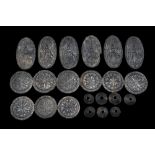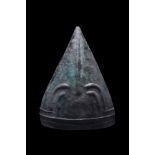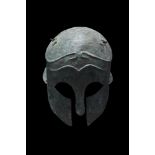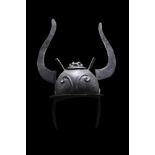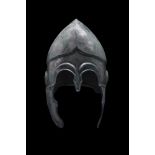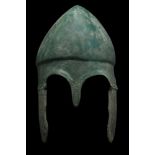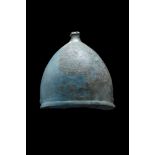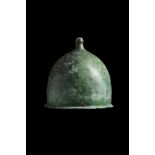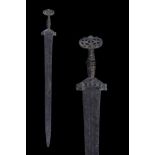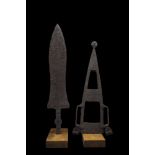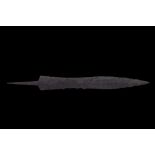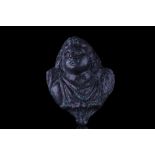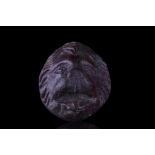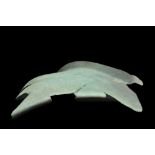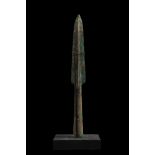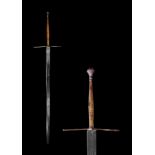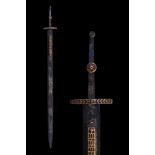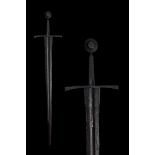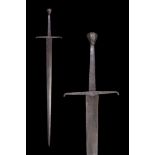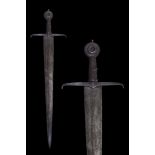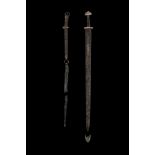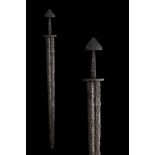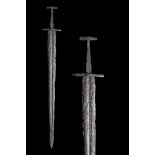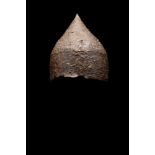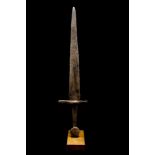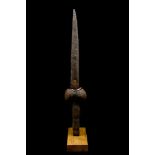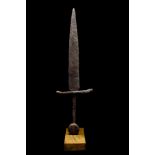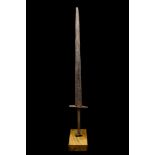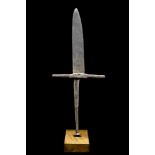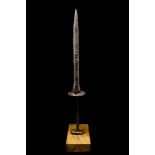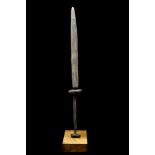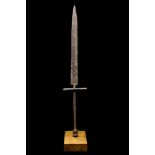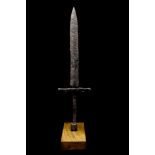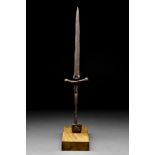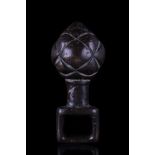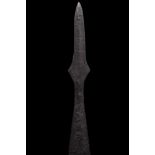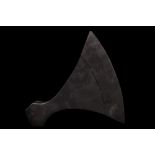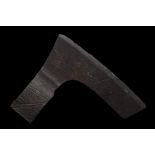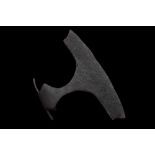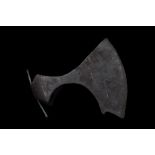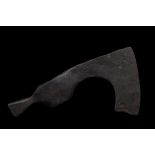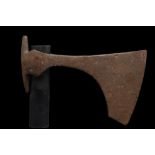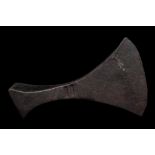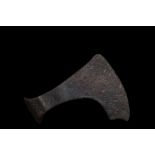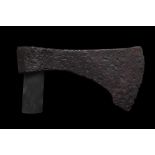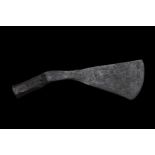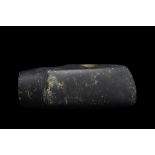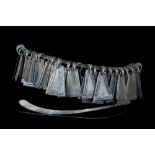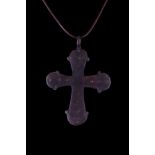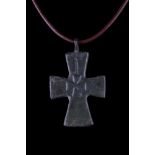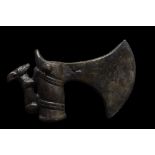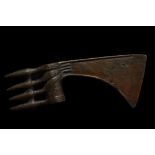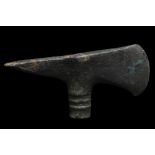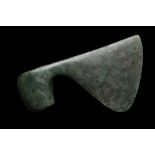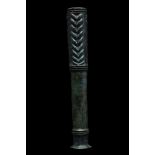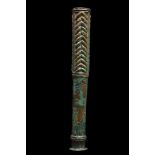Refine your search
Filtered by:
- Category
- List
- Grid
A subscription to the Price Guide is required to view results for auctions ten days or older. Click here for more information
Ca. 300-200 BC. Bronze plated with embossed silver plates. There are two types of phalerae in the set. Six phalerae in the form of oval plates wit...
URARTIAN BRONZE HELMET
Ca. 800-700 BC. A helmet formed of hammered bronze sheet of conical form with two bands of horizontal raised ribs around the bottom edge. The helm...
Ca. 600 BC. A bronze combat helmet of Archaic Corinthian-Type, hammered from a single sheet of bronze with finely contoured almond-shaped eyes tha...
Ca. 400 BC. A bronze helmet forged from a single hammered sheet with a finely central crest in high relief depicting a stylised gorgoneion with in...
Ca. 500-300 BC. A helmet comprising of hammered tinned bronze. The domed crown with front with medial ridge, with contoured double curve above the...
Ca. 500-300 BC. A superb Chalcidian helmet. The bowl is forged in one piece, featuring high-arched eyebrows with an ear drop-shaped nose guard and...
Ca. 100-50 BC. A Buggenum type bronze helmet with a rounded bowl, folded brim, and projection on the top for attaching a plume. This was the most ...
Ca. 1st century BC - 1st century AD. A relatively light bronze legionary helmet with bulbous domed bowl, small crest knob with flattened top, pier...
Ca. 800-500 BC. Straight double edged iron blade. Bronze handle, with trapezoid guard, bronze grip, widening towards the middle, where a ridge is ...
Ca. 100 AD. An iron pugio, or squat triangular dagger with a midrib and rivet holes to accept a handle. This dagger comes with its beautiful scabb...
Ca. 100-200 AD. An iron gladius blade with waisted edges, a triangular tip, and a long tang. The gladius was a key part of Roman military equipmen...
Ca. 100-300 AD. A bronze die for casting mounts in the form of a bust of Cupid (Greek Eros) with fleshy features and curly hair. His chubby cheeks...
ROMAN BRONZE LION HEAD PHALLERA
Ca. 100-200 AD. A cast bronze phalera formed as a lion's mask. The animal's head with prominent brow and eyes, an open mouth, and a detailed mane ...
Ca. 1-100 AD. A sheet-bronze cheekpiece from a Coolus type helmet. This type of helmet was usually hammered from bronze and it was most popular du...
Ca. 800-600 BC. A socketed bronze spearhead comprising a substantial lentoid-section blade with raised midrib, and a long shaft. Hoplites were the...
Ca. Late 16th century AD or earlier. A colossal two-handed sword, possibly of German workmanship, straight double-edged blade with wide and shallo...
Ca. 600 AD. A long Migration period iron sword with rare patterned Damascus steel blade, comprising a lentoid-section parallel-sided blade with a ...
Ca. 1350 AD. This late Medieval sword comprises of a long slender triangular blade with a fuller, three quarters of its length and an undamaged ta...
Ca. 1330-1450 AD. This sword is the epitome of épées, a truly magnificent example. The pommel is very elegant and appropriately called a ‘scent bo...
Ca. 1400-1450 AD. This is an excellent and somewhat complete sword from the late Medieval period. The pommel is a circular disc, with a raised cir...
Ca. 900-1100 AD. An excellent set comprising a leather belt with bronze fittings including a D-shaped buckle with a pin, chevron mount and interli...
VIKING IRON SWORD - FULL REPORT
Ca. 10th Century AD. This sword of the Viking era is largely intact, with the pommel, lower cross guard, blade, and tang all complete. The surface...
VIKING IRON SWORD - FULL REPORT
Ca. 10th Century AD. A wonderful example of a Hiberno-Norse sword, typically originating in the Irish Sea area about a thousand years ago. It is a...
Ca. 900-1000 AD. A rare Viking period iron helmet; formed of triangular sections; attached with iron rivets passing through this overlap to secure...
Ca. 13th-15th century AD. An iron dagger with a broad triangular blade, straight cross guard, and flat-section tapering tang finished with a disco...
Ca. 15th-16th century AD. An iron Bollock dagger / knife. The handle is of wood and a hilt plate survives between the cross guard and blade. There...
MEDIEVAL BROAD BLADED DAGGER
Ca. 13th-15th century AD. An iron dagger with a broad triangular blade, long cross guard, slightly curved downwards and flat-section tapering tang...
Ca. 13th-15th century AD. A short iron sword comprising a slender blade with pronounced midrib, a short flat cross guard, and a flat square pommel...
Ca. 13th-15th century AD. A short iron single-edged dagger/knife, with a straight cross guard and tapering tang to floret button pommel.Size: L:39...
Ca. 14th-15th century AD. An iron dagger / stiletto with a slender blade tapering to a point, a round cross guard embellished to the bottom face w...
Ca. 14th-15th century AD. An iron dagger/stiletto featuring a double-edged slender blade with a button-shaped cross guard, rectangular-section ta...
Ca. 13th-15th century AD. A long iron dagger comprising a slender blade with a midrib, a straight cross guard, and a rounded/cylindrical pommelSiz...
Ca. 13th-15th century AD. A short iron double-edged dagger with a straight sculptured cross guard and tapering tang to rod-shaped pommel.Size: L:3...
Ca. 14th-15th century AD. An iron dagger or poniard comprising a slender blade with pronounced midrib, a short curved cross guard with balls on bo...
VIKING AGE BRONZE MACE HEAD
Ca. 900-1100 AD. A bronze mace head with a pear-shaped head with incised decoration, tapering shaft, and rectangular-shaped opening for attachment...
VIKING IRON SOCKETED SPEARHEAD
Ca. 900-1100 AD. An iron spearhead with a beautifully shaped blade, raised midrib, sharp edges tapering to a pointed tip, and tubular socket. Spea...
VIKING IRON BATTLE AXE
Ca. 900-1100 AD. A hand-forged iron axe head with a broad blade flaring to the curved cutting edge, with an eared socket with an oval-shaped apert...
VIKING IRON BATTLE AXE
Ca. 900-1100 AD. An iron bearded axe head with an elongated, heavy blade and a round socket. One side of the blade features etched star motifs. Fu...
VIKING IRON "DANNISH" BATTLE AXE
Ca. 1000-1100 AD. An iron axe head with a broad blade flaring to the curved cutting edge, with an eared socket with a round aperture. Commonly ref...
VIKING IRON BEARDED BATTLE AXE
Ca. 900-1100 AD. An iron bearded axe head with an elongated blade and a socket. In bearded axes, the main part of the axe blade extends below the ...
VIKING IRON BATTLE AXE
Ca. 900-1100 AD. A forged-iron axe head of a sizeable form with a long neck, a verticle blade with flared tips, and a wide socketing shaft with sl...
VIKING IRON BEARDED BATTLE AXE
Ca. 900-1100 AD. An iron bearded axe head with an elongated, curved blade and tapering cheek. The bearded axe, or Skeggøx (from Old Norse Skegg, "...
VIKING IRON BATTLE AXE
Ca. 900-1100 AD. An iron axe head with a curved blade, slim cheek, and an elliptical shaft-hole. Axes were commonly used within the Viking communi...
VIKING IRON BATTLE AXE
Ca. 900-1100 AD. A hand-forged, iron axehead with substantial curved blade and elliptical shaft-hole. The era known as the Viking age lasted for m...
VIKING IRON BATTLE AXE
Ca. 900-1100 AD. An iron battle axe with a broad blade, tapering cheek and a round socket. The bearded axe was common from the 6th century AD onwa...
VIKING IRON BATTLE AXE
Ca. 900-1100 AD. An iron axe head with a curved cutting edge, narrow circular socket, and a hammer to the rear. The blade to one side and the hamm...
NEOLITHIC STONE AXE
Ca. 5000-3000 BC. A nice boat-shaped stone axe head with a square butt and rectangular in section, the ground socket with expanding edge has a hol...
VIKING NECK TORC WITH TASSLES
Ca. 900-1100 AD. Beautiful bronze torc featuring a wide, flat neck piece decorated with incised geometric motifs, from which dangle dozens of meta...
MEDIEVAL BRONZE CROSS PENDANT
Crusaders Period, Ca. 1100-1400 AD. A bronze cruciform pendant with scalloped arms and an integral circular suspension loop. The obverse features ...
Ca. 1100-1400 AD. A bronze cruciform pendant with arms tapering in towards the center. At the junction, there is a Maltese Cross in relief. The su...
Western Asiatic, Ca. 1200-700 BC. An attractive ceremonial axe head with flared blade and wide, cylindrical shaft tube. On the back, a solid bronz...
BRONZE AGE BRONZE AXE HEAD
Ca. 1500-1000 BC. A bronze axe head featuring a curved blade with a tapering cheek, and a pick end with four spikes. An axe such as this one would...
BRONZE AGE BRONZE ADZE AXE
Ca. 2000-700 BC. A double axe-head cast in bronze. The weapon features a short cylindrical shaft hole with two horizontal bands, a flattened top w...
BRONZE AGE BRONZE AXE HEAD
Ca. 1500-1000 BC. A cast bronze war axe head featuring a cylindrical shaft and a flattened blade, drawn out from the top of the shaft, broadens ou...
Ca. 3rd millennium BC. A cast bronze mace head/cudgel of a tubular shape. The upper part is decorated with 9 rows of raised chevrons, separated by...
Ca. 3rd millennium BC. A cast bronze mace head/cudgel of a tubular shape. The upper part is decorated with panels of 13 rows of raised chevrons, s...

